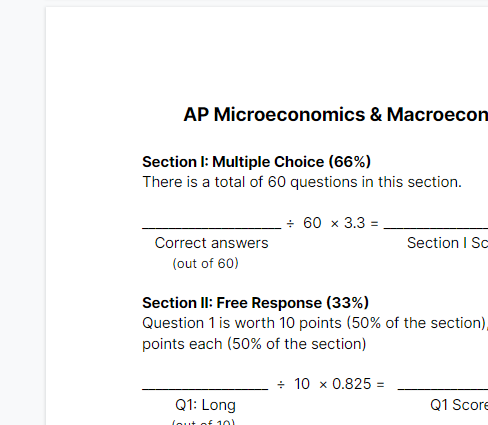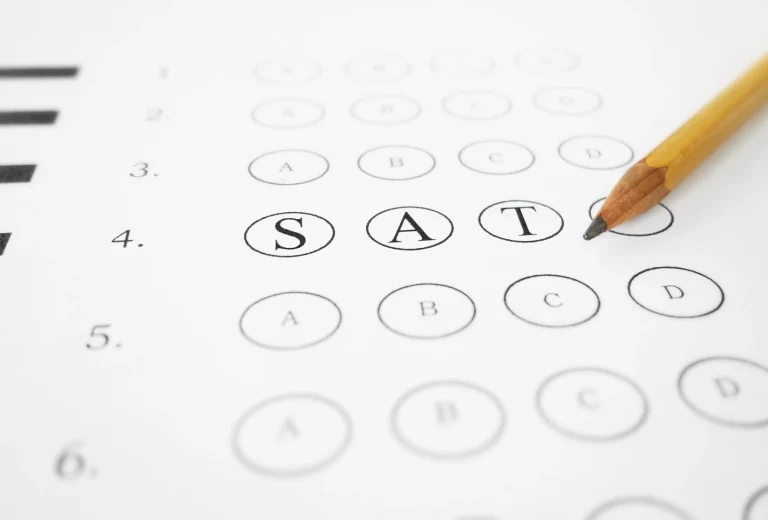Economics is one of the most popular AP subjects offered by the College Board, with a consistent volume of more than 100,000 test-takers every year. Before going further into analyzing each subject, we will provide overview information about AP Macroeconomics and AP Microeconomics to help you understand the expectations and requirements of each subject.
Exam Information
1. AP Microeconomics
AP Microeconomics mainly involves four major parts: Economic Fundamentals, The Role of Government, market failure, and market structure. The course’s main purpose is to introduce students to principles that apply to individual economic decision-makers, whether they are consumers or producers.
The course prepares students to think like economists by using principles and models to describe economic situations and predict and explain outcomes. The economics of pricing in microeconomics is the economics of individuals. It mainly emphasizes the nature and function of the product market. It also studies the role of factor markets and the government in promoting economic efficiency and fair operation.
Exam Length: 2 hours 10 minutes (130 minutes)
- 60 multiple-choice questions, 70 minutes for this section.
- 3 short answer questions, with 60 minutes of time.
Units of study and Exam Weight
Main Content Topic | Exam Weight |
Basic economic concepts | 12%-15% |
Supply and demand | 20%-25% |
Production, cost, perfect competition model | 22%-25% |
Imperfect competition | 15%-22% |
Factor markets | 10%-13% |
Market failure and the role of government | 8%-13% |
2. AP Macroeconomics
AP Macroeconomics aims to help students to think about economic operation of the whole society. Students will have the perspective of social policymakers in considering issues in the market. Upon completion of this course, students will be able to interpret the causes and effects of interest rate cuts by banks, rising prices, and the impact of trade deficits on exchange rates in the market.
Exam Length: 2 hours 10 minutes (130 minutes)
- 60 multiple-choice questions, 70 minutes for this section.
- 3 short answer questions, with 60 minutes of time.
Units of study and Exam Weight
Main Content Topic | Exam Weight |
Basic economic concepts | 5%-10% |
Economic indicators and business cycles | 12%-17% |
National income and price determination | 17%-27% |
Financial sector | 18%-23% |
Long-term consequences of stabilization policies | 20%-30% |
Open economy-international trade and finance | 10%-13% |
Score Distribution
The score distribution of each AP Microeconomics and Macroeconomics exam is also a good reference for students to prepare accordingly. The following is the score distribution of each in 2022 (the number is rounded up to the nearest whole number:
Subject | 5 points | 4 points | 3 points | 2 minutes | 1 point |
AP Macroeconomics | 16.4% | 20% | 15.4% | 15.1% | 33.1% |
AP Microeconomics | 17.7% | 22.5% | 18.8% | 16.9% | 24.2% |
Which one should I take?
Although there are differences between AP Microeconomics and AP Macroeconomics, the learning methods used in each class are basically the same. Concepts such as demand, supply and aggregate demand, and aggregate supply have similarities in the core concept, just different applications. Students can prepare for both AP Microeconomics and AP Macroeconomics at the same time. If time is limited and students have other important courses to finish within the semester, students are advised to prepare for AP Microeconomics.
Test preparation suggestion
1. Practice with Real Exams
The questions in the exam are good preparation materials. From the real questions, students can study and analyze the solving methods of the questions. Real questions are also a good model to understand the difficulty of the actual exam. College Board provides excellent past tests and practice questions from 1998 to 2019 for Macroeconomics and Microeconomics. There are also prep books on the market that provide AP-style practice tests. However, remember to select books from credible and famous companies like College Board itself, Magoosh, The Princeton Review or Kaplan.
2. Study Plan
Basically, it is recommended to start an intensive preparation in early March, familiarize yourself with all the knowledge in early April, and do more real questions from mid-to-late April to before the exam. We’ve integrated Magoosh’s 3-month study plan with our teacher’s advice, based on the deadline of the AP Macroeconomics exam in 2023 to help you succeed!
AP Microeconomics
Week | Practice Test | BC Review |
Week 1 (2/3 – 2/9) | 2 Practice Tests | Review test |
Week 2 (2/10 – 2/16) |
| Basic economic concepts |
Week 3 (2/17 – 2/23) |
| Supply and demand |
Week 4 (2/24 – 3/2) | 2 Practice Tests | Review test |
Week 5 (3/3 – 3/9) |
| Production, cost, perfect competition model |
Week 6 (3/10 – 3/16) |
| Imperfect competition |
Week 7 (3/17 – 3/23) | 3 Practice Tests | Review test |
Week 8 (3/24 – 3/30) |
| Factor markets |
Week 9 (3/31- 4/6) |
| Market failure |
Week 10 (4/7 – 4/13) | 3 Practice Tests | Review test |
Week 11 (4/14– 4/20) |
| The role of government |
Week 12 (4/21– 4/27) | 3 Practice Tests | Review test |
Week 13 (4/28 – 5/4) | Practice Test 2018 + 2019 | All topics |
May 5, 2023 | AP Microeconomics Exam day! |
|
AP Macroeconomics
Week | Practice Test | BC Review |
Week 1 (2/9 – 2/15) | 2 Practice Tests | Review test |
Week 2 (2/16 – 2/22) |
| Basic economic concepts |
Week 3 (2/23 – 3/1) |
| Economic indicators and business cycles |
Week 4 (3/2 – 3/8) | 2 Practice Tests | Review test |
Week 5 (3/9 – 3/15) |
| National income and price determination |
Week 6 (3/16 – 3/22) |
| Financial sector |
Week 7 (3/23 – 3/29) | 3 Practice Tests | Review test |
Week 8 (3/30 – 4/5) |
| Long-term consequences of stabilization policies |
Week 9 (4/6 – 4/12) |
| Open economy-international trade and finance |
Week 10 (4/13 – 4/19) | 3 Practice Tests | Review test |
Week 11 (4/20 – 4/26) | 3 Practice Tests | Review test |
Week 12 (4/27 – 5/3) | Practice Test 2018 + 2019 | All topics |
May 4, 2023 | AP Macroeconomics Exam day! |
|
3. Practice drawing and reading graphs
Whether it is microeconomics or macroeconomics, the mastery of graphs is the top priority, because both courses require you to extensively use graphs, charts, and data in describing economic situations and predict and explain outcomes. There are many questions about the identification of graphs in the multiple-choice questions, and students are required to create graphs or visual representations in performing numerical analysis and calculation for a stated problem.
AP Microeconomics and Macroeconomics Score Calculator
This is a projected calculation of your AP Macro and Micro Scores for 2022 . Please keep in mind that this score will not accurately reflect your score, but this is our projection based on the scoring guidelines given by College Board.
There are 60 questions for the multiple-choice section, which is worth 66% of your score, and 3 Free Response Questions – 1 Long (10 points) and 2 Short Questions (5 points each), which are worth 33% of your score.
You can calculate your point by this formula:
(Multiple Choice Score / 60 x 3.3) + 2 x (Free Response Score / 10 x 0.825) = Total Score
Introducing Aralia Test Preparation Bootcamp, where students can excel in standardized tests with our comprehensive approach. At Aralia, we prioritize maximizing study efficiency and accelerating score improvement through a combination of practice examinations, expert strategies, and personalized guidance. Our Bootcamp offers students the opportunity to achieve significant score improvements within a condensed timeframe by learning strategic approaches tailored to their individual needs. With instructors who are AP readers, students benefit from expert teaching and gain valuable insights into exam techniques. Furthermore, our program equips students with versatile skills and strategies that can be applied to a range of standardized tests, ensuring they are well-prepared to adapt to various exam types.

FREE AP Scoring Worksheet
With the scoring worksheet, you will be able to calculate your target score in preparation for the upcoming exam in May. We also have a full scoring worksheet available below if you want to print it out and keep it in your folder.
Aspiring entrepreneurs will create, promote, and market a company to win over the Diamond Challenge Business Competition’s judges. In this intensive format, students will conduct the business ideation process, create a business plan, conduct environmental scanning, establishing the organizational mission, vision, and value statements, create marketing and promotion strategies, write the business proposal and create a pitch deck required by the Diamond Challenge Business Competition.
This is a college-level introduction to Economics course that covers important concepts in microeconomics and macroeconomics. Related disciplines such as accounting, finance, and financial markets will also be covered. The primary goal is to develop and then build on your understanding of the analytical tools and approaches used by economists. Students will gain a better understanding of policymaking tools, international trade, market structures, the financial markets, and more.
Students will use college-level economic theory and models to analyze the financial impact on the global economy. The economic tutor will provide students with the models and tools necessary to write an economic research paper. The economic research project encourages students to integrate their acquired knowledge of economic theory, phenomenon, data, and policy.
The purpose of AP Exam prep course is to equip AP Macroeconomics students to excel on the 2021 AP Macroeconomics exam. You will develop a profound understanding of the economic concepts, and the ability to define, analyze and explain economic principles and models.









